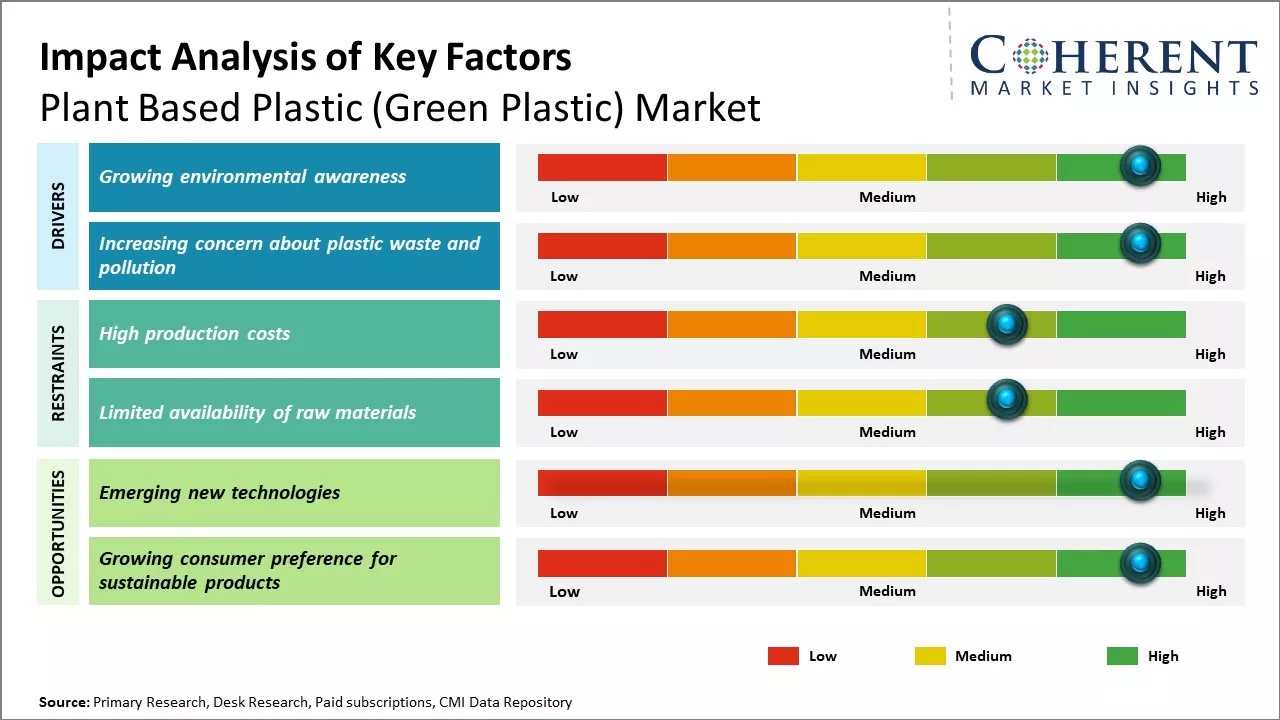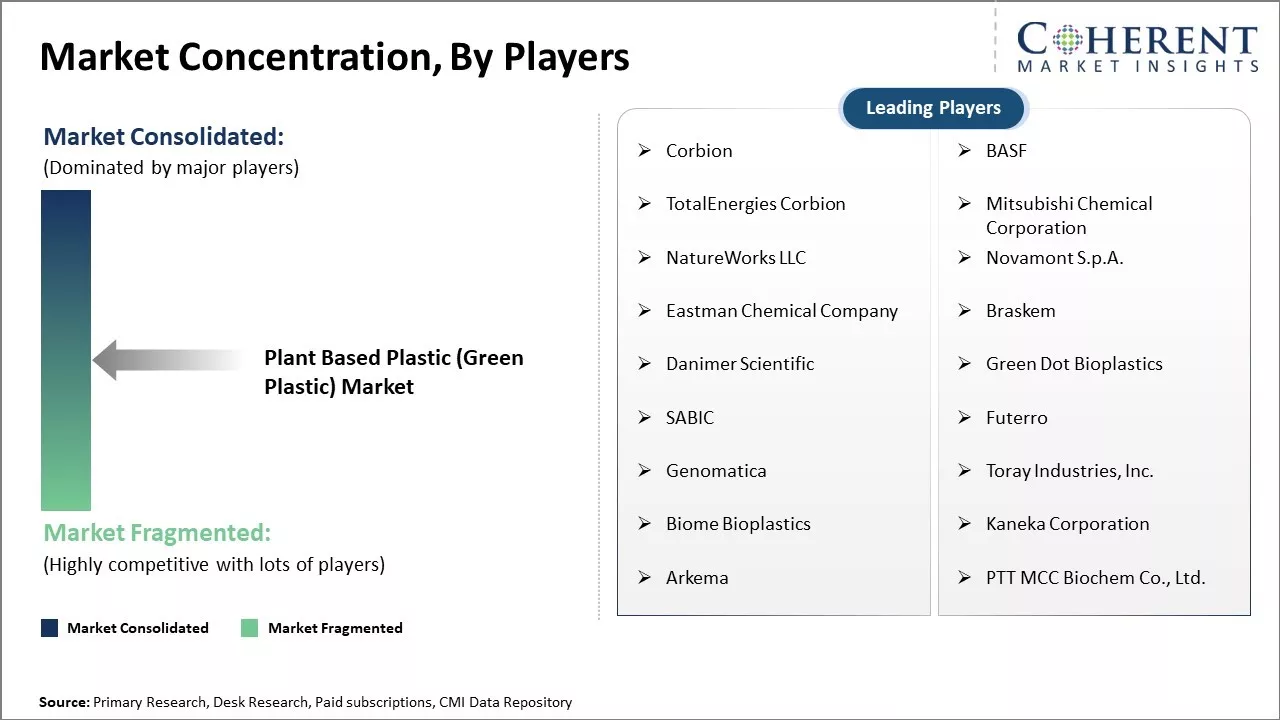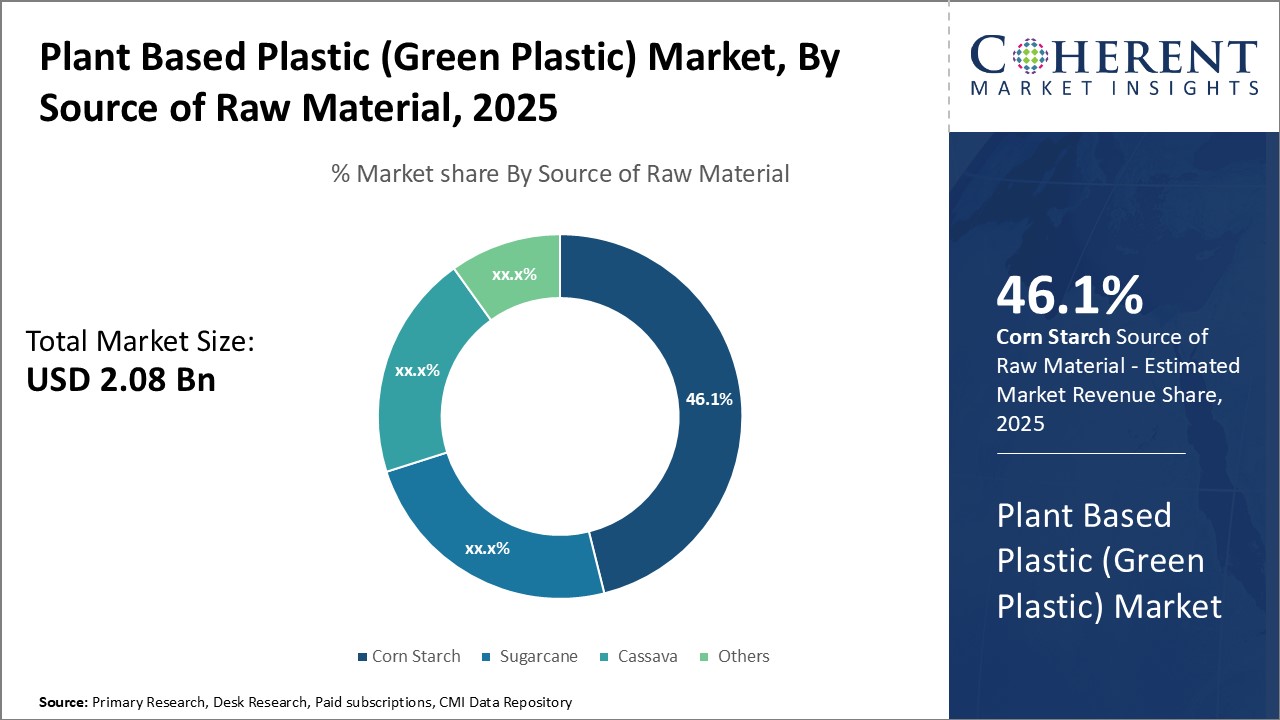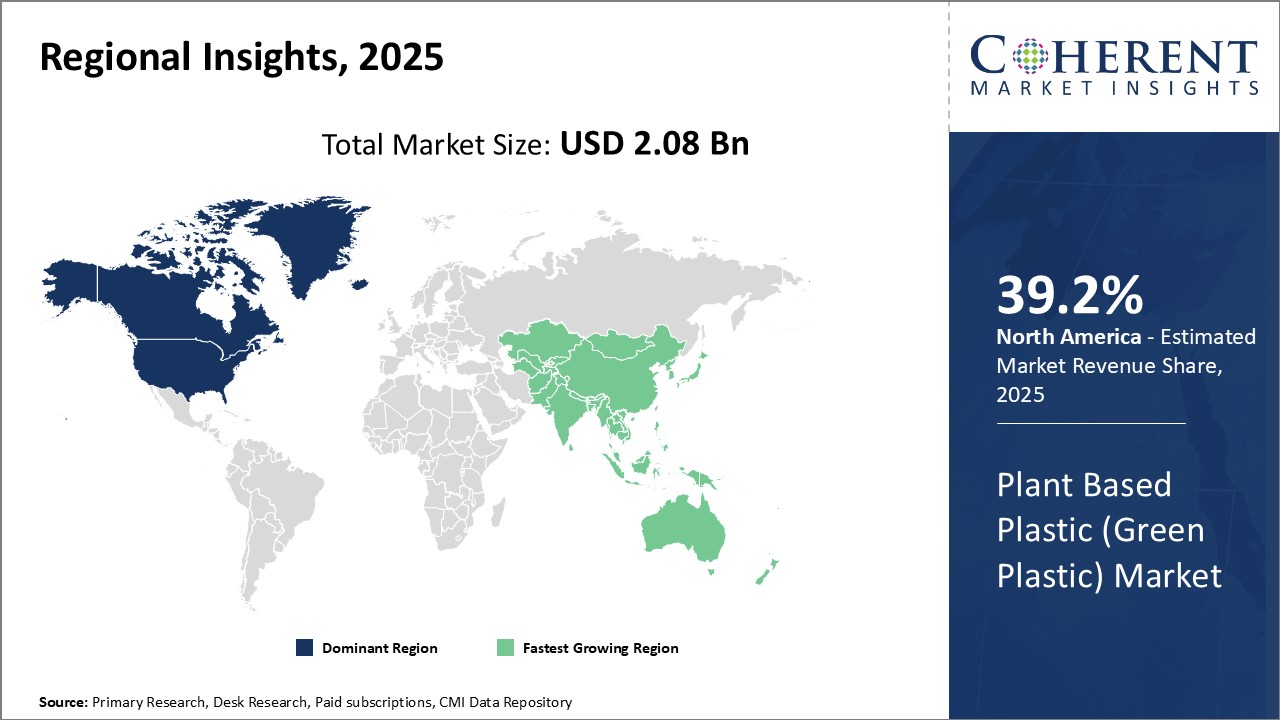Plant Based Plastic (Green Plastic) Market Size and Trends
The Plant Based Plastic (Green Plastic) Market is estimated to be valued at USD 2.08 Bn in 2025 and is expected to reach USD 4.24 Bn by 2032, exhibiting a compound annual growth rate (CAGR) of 10.7% from 2025 to 2032.

Discover market dynamics shaping the industry: Download Free Sample
Increasing demand for biodegradable and sustainable plastic from various end-use industries such as packaging, textiles, automotive, and others is driving the market growth. The Plant Based Plastic (Green Plastic) Market is expected to witness strong growth on account of rising environmental concerns around non-biodegradable plastics. Stringent government regulations regarding single-use plastic usage and investments by leading companies to develop innovative and affordable bioplastic solutions will further aid the market expansion. Also, the growing acceptance of plastic replacements by consumers and brands will accelerate the shift towards sustainable plastic alternatives.
Market Driver - Growing environmental awareness
With growing awareness regarding the damaging effects of conventional plastics on the environment, people are looking for more sustainable alternatives. There is a sense of urgency among both individuals and organizations to adopt eco-friendly options. Young consumers, in particular, want to make informed choices and reduce their plastic footprint. Manufacturers realize this changing mindset and are actively scouting for innovative but greener materials.
Plant-based plastics seem to be filling this gap very well. Plant-based plastics, they are derived from biomass sources like Sugarcane, cassava root, corn, or even agricultural waste. These plastics have a renewable and natural origin instead of depending on finite fossil fuel reserves. Numerous studies have highlighted how conventional plastics take centuries to decompose while green plastics can break down within just a few months after use under composting conditions. This biodegradability makes them far more sustainable for single-use applications. Recyclability is also better as they can be processed in municipal composting facilities along with food waste.
With ever-increasing climate change concerns, many governments and policymakers are aggressively promoting bio-based and biodegradable alternatives. Favorable regulations provide production incentives as well as mandate the use of sustainable materials in specific product segments. Even influential retail giants and food conglomerates seek "green" packaging suppliers. Their vast sourcing power and environment-conscious customer base create a huge pull for natural plastics.
Market Concentration and Competitive Landscape

Get actionable strategies to beat competition: Download Free Sample
Increasing concern about plastic waste and pollution
The issue of plastic pollution is gaining global attention due to dramatic visuals of its disastrous effects. Mountains of non-degradable waste choking landfills and plastic debris littering oceans have sparked outrage. For instance, In March 2022, the United Nations Environment Assembly (UNEA) passed a historic resolution to develop an international legally binding agreement to address plastic pollution. This resolution was adopted by 175 nations, demonstrating the widespread recognition of plastic pollution as a critical environmental issue that requires coordinated global action.
People now recognize synthetic polymers as a serious threat, especially single-use plastics that find immense applications across sectors. The ongoing pandemic has further amplified plastic usage but also plastic garbage in public places. Proper waste management remains a challenge in most developing nations. Growing distances between source and disposal also impact the efficiency of plastic recycling processes. These factors have underlined the unsuitability of conventional plastics in a linear "take-make-waste" model.
Governments and global bodies are working to curb marine plastic pollution through prohibitions, levies, and international co-operation. Recent bans target ubiquitous disposable plastic items like bags, straws, cutlery and Styrofoam cups. Industry is under pressure to develop innovative solutions and invest in bio-alternatives. Companies realize end consumers want brands that demonstrate concern for the planet through their product choices and operations.
Plant-based plastics have comparable functionality but ensure plastic waste stays out of sensitive ecosystems. Their compostable nature is reassuring from a post-consumer perspective. The urgency to address the plastic pollution pandemic and transition to a circular economy presents fertile ground for natural and biodegradable alternatives like plant-based plastics.
Key Takeaways from Analyst:
Major drivers for adoption of Plant-based plastics include increasing environmental regulations around the world restricting single-use plastics as well as growing consumer demand for sustainable packaging solutions. Manufacturers are increasingly focusing on developing competitive plant-based alternatives to fossil fuel-based plastics to address these trends. Several bioplastics such as PLA, bio-PE, and bio-PET have gained traction in applications such as food service wares.
However, high material and production costs remain a key challenge restraining wider market penetration. Additionally, the limitations of current plant-based plastics in terms of barrier properties and functionality also restricts their use in applications that demand high-performance. Technological innovations to make plant-based plastics more cost effective and improve performance characteristics will thus be critical for future growth.
North America dominates the market while Asia Pacific is the fastest-growing regional market. The Asia Pacific region especially countries like India, Indonesia, and Thailand is expected to see strong gains due to the right agro-climatic conditions and large biodiversity supporting the cultivation of key biomass feedstocks.
Market Challenge - High production costs
One of the major challenges faced by the Plant Based Plastic (Green Plastic) Market is the high production costs involved compared to traditional plastics. Plant-based plastics are more expensive to produce as they require the use of plant-based raw materials such as vegetable oils, starch, etc. instead of crude oil. Producing plastics from crops also involves an extensive agricultural process which increases costs. Further, setting up production facilities capable of processing these agricultural feedstocks at industrial scales requires large capital investments. The technologies needed to convert plant-based compounds into usable plastics are also complex and not widely available, necessitating high initial R&D investments. These factors contribute to making plant-based plastics approximately 10-30% more expensive than conventional plastic options at present. Unless production costs come down significantly, plant plastics may struggle to achieve price parity and mass market acceptance.
Market Opportunity: Emerging New Technologies
One of the major opportunities for the Plant Based Plastic (Green Plastic) Market is the emergence of new technologies that can help drive down production costs. Startups and material science companies are actively working on developing innovative production methods that optimize resource and energy efficiency. For example, newer enzymatic and microbial-based processes can convert plant materials into plastic monomers much faster than traditional thermochemical approaches. Emerging technologies in extraction methods, smart catalysis, and metabolic engineering also promise to simplify plant plastic manufacturing and reduce waste. Adoption of automation and data-driven process optimization can further lower capital and operating costs over time. Such advancements will help plant plastics achieve price competitiveness with fossil-fuel based plastics in the next 5-10 years. This presents a opportunity for market growth as environmental consciousness and sustainability demands increase worldwide.

Discover high revenue pocket segments and roadmap to it: Download Free Sample
Insights by Source of Raw Material: Sustainable and versatile, corn starch is leading the way in adoption within the raw material segment.
In terms of source of raw material, the corn starch segment is estimated to hold 46.1% share of the market in 2025, owing to its sustainability and versatility. Corn is one of the most abundantly cultivated crops worldwide and the raw material is easily accessible for plastic manufacturers. Corn starch based plastics are 100% biodegradable and compostable, allowing them to be safely disposed without harming the environment. Their production also sequesters carbon from the atmosphere and requires significantly less fossil fuel usage compared to traditional plastics.
Corn starch plastics can be molded into a variety of forms and shapes due to their thermoplastic properties. This makes them suitable for diverse packaging applications ranging from rigid containers and clamshells to flexible films. They maintain durability throughout distribution chains but readily decompose at the end of product life. This ease of disposal reduces reliance on landfills and incineration. Manufacturers are further optimizing corn starch compositions to improve barrier and mechanical performance for broader use cases.
Alternative sources like cassava and sugarcane present supply chain and logistical challenges for plastic fabricators. Cassava requires tropical cultivating conditions while sugarcane growth depends on climatic conditions. Both have more limited and concentrated global production compared to corn. Other novel sources such as algae and potato also have technical and economic barriers restricting their widespread commercialization. Given corn's abundant and reliable supply combined with starch plastic's inherited sustainability, it is expected to lead this segment for the foreseeable future.
Insights by Type: Superior properties and processing drive segment growth
In terms of type, PLA (Polylactic Acid) segment is estimated to hold 33.9% share of the market in 2025, due to its desirable material properties and easy processability. PLA is produced from lactic acid derived from renewable resources like corn starch through fermentation. Its molecular structure grants characteristics similar to conventional plastics like polypropylene and polystyrene. However, PLA has an edge with improved sustainability as it biodegrades into carbon dioxide, water and biomass at the end of use phase.
Unlike other plant-based types, PLA offers high strength and rigidity allowing complex product manufacturing using common plastic molding and thermoforming techniques. It maintains physical stability during normal usage conditions but designed triggers like high temperatures or exposure to microbes initiate breakdown. This provides convenience to users by eliminating need for separation at disposal. PLA's attributes also make it suitable for injection and blow molding of bottles, clamshells and durable consumer goods.
While Polyhydroxyalkanoates (PHA) and starch plastics have niche applications, their limited strength, barrier properties, and higher production costs restrict broad market penetration. Emerging technologies are being researched to address these constraints but commercialization remains distant. PLA currently offers the optimal mix of renewability, performance characteristics, and cost viability preferred by brand owners and retailers looking to transition from fossil feedstock plastics. Growing expansion by key players is expected to drive the segment growth. For instance, in October 2023, NatureWorks LLC, a PLA manufacturer, announced its commencement of a PLA facility in Thailand.
Insights by End-use Industry: The demand for packaging is driving growth in the end-use sector
In terms of end-use industry, Packaging estimated to hold 39.2% share of the market in 2025, due to strong demand driven by sustainability regulations and brand commitments. Packaging manufacturing is moving towards plant-based bioplastics to meet recycling mandates and eliminate single-use plastics. Major food companies have set science-based greenhouse gas emission reduction targets necessitating renewable feedstocks.
The packaging segment is well placed to leverage the properties of bioplastics like PLA, starch blends, and PHA which can be molded into rigid, flexible, and multi-layered structures. Their permeability characteristics also allow modified atmosphere and breathable food packaging solutions. Being compostable, plant-based packaging enables waste diversion from landfills through industrial or home composting. These addresses pressing global plastic pollution issues attracting institutional investments into infrastructure development. Overall, favorable regulations, brand commitments, and infrastructure growth are directing the end use shift towards renewable bioplastic packaging solutions.
Regional Insights

Need a Different Region or Segment? Download Free Sample
In 2025, North America is estimated to dominate Plant Based Plastic (Green Plastic) Market, holding a significant share of 39.2%. This leadership is driven by a robust demand for sustainable packaging solutions across various industries, including food and beverage, consumer goods, and automotive. The region benefits from a strong regulatory framework that encourages the adoption of eco-friendly materials, alongside increasing consumer awareness regarding environmental issues. Major companies such as Corbion, BASF in the U.S. and Canada are investing heavily in research and development to enhance the properties of plant-based plastics, making them more competitive with traditional petroleum-based plastics. Additionally, the presence of established players and innovative start-ups in the bioplastics sector further bolsters market growth. As businesses and consumers alike shift towards greener alternatives, North America is poised to maintain its prominent position in the global plant-based plastic landscape.
The Asia Pacific region has emerged as the fastest growing market for plant based plastics. Rapid industrialization and rising disposable incomes have fueled the growth of the consumer packaging industry in the region. The huge production capacities of FMCG goods in countries like China, India, and Indonesia have increased the demand for eco-friendly plastic packaging materials from both domestic as well as export markets. At the same time, growing environmental consciousness and policy push for circular economy is nudging the manufacturers to incorporate sustainable solutions. Established players from Europe have partnered with local producers to transfer technology and tap into the massive market potential. With inexpensive labor and abundant availability of agricultural residues, the production costs are significantly lower in Asia Pacific making it an attractive destination for global suppliers. If the government regulatory framework is strengthened to promote innovation and incentivize investments, the region is set to dominate the industry in the future.
Market Report Scope
Plant Based Plastic (Green Plastic) Market Report Coverage
| Report Coverage | Details | ||
|---|---|---|---|
| Base Year: | 2024 | Market Size in 2025: | USD 2.08 Bn |
| Historical Data for: | 2020 To 2024 | Forecast Period: | 2025 To 2032 |
| Forecast Period 2025 to 2032 CAGR: | 10.7% | 2032 Value Projection: | USD 4.24 Bn |
| Geographies covered: |
|
||
| Segments covered: |
|
||
| Companies covered: |
Corbion, BASF, TotalEnergies Corbion, Mitsubishi Chemical Corporation, NatureWorks LLC, Novamont S.p.A., Eastman Chemical Company, Braskem, Danimer Scientific, Green Dot Bioplastics, SABIC, Futerro, Genomatica, Toray Industries, Inc., Biome Bioplastics, Kaneka Corporation, Arkema, and PTT MCC Biochem Co., Ltd. |
||
| Growth Drivers: |
|
||
| Restraints & Challenges: |
|
||
Uncover macros and micros vetted on 75+ parameters: Get instant access to report
Market Segmentation
- Source Of Raw Material Insights (Revenue, USD Bn, 2020 - 2032)
-
- Corn Starch
- Sugarcane
- Cassava
- Others (Soy, Potato, Algae, etc.).
- Type Insights (Revenue, USD Bn, 2020 - 2032)
-
- PLA (Polylactic Acid)
- PHA (Polyhydroxyalkanoates)
- Starch-Based Plastics
- Other
- End-use Industry Insights (Revenue, USD Bn, 2020 - 2032)
-
- Packaging
- Textile
- Automotive & Transport
- Electronics & Electricals
- Coatings & Adhesives
- Agriculture & Horticulture
- Others (Building & Construction, etc.)
- Regional Insights (Revenue, USD Bn 2020 - 2032)
-
- North America
- U.S.
- Canada
- Latin America
- Brazil
- Argentina
- Mexico
- Rest of Latin America
- Europe
- Germany
- U.K.
- Spain
- France
- Italy
- Russia
- Rest of Europe
- Asia Pacific
- China
- India
- Japan
- Australia
- South Korea
- ASEAN
- Rest of Asia Pacific
- Middle East
- GCC Countries
- Israel
- Rest of Middle East
- Africa
- South Africa
- North Africa
- Central Africa
- North America
- Key Players Insights
- Corbion
- BASF
- TotalEnergies Corbion
- Mitsubishi Chemical Corporation
- NatureWorks LLC
- Novamont S.p.A.
- Eastman Chemical Company
- Braskem
- Danimer Scientific
- Green Dot Bioplastics
- SABIC
- Futerro
- Genomatica
- Toray Industries, Inc.
- Biome Bioplastics
- Kaneka Corporation
- Arkema
- PTT MCC Biochem Co., Ltd.
Share
Share
About Author
Yash Doshi is a Senior Management Consultant. He has 12+ years of experience in conducting research and handling consulting projects across verticals in APAC, EMEA, and the Americas.
He brings strong acumen in helping chemical companies navigate complex challenges and identify growth opportunities. He has deep expertise across the chemicals value chain, including commodity, specialty and fine chemicals, plastics and polymers, and petrochemicals. Yash is a sought-after speaker at industry conferences and contributes to various publications on topics related commodity, specialty and fine chemicals, plastics and polymers, and petrochemicals.
Missing comfort of reading report in your local language? Find your preferred language :
Transform your Strategy with Exclusive Trending Reports :
Frequently Asked Questions
EXISTING CLIENTELE
Joining thousands of companies around the world committed to making the Excellent Business Solutions.
View All Our Clients
